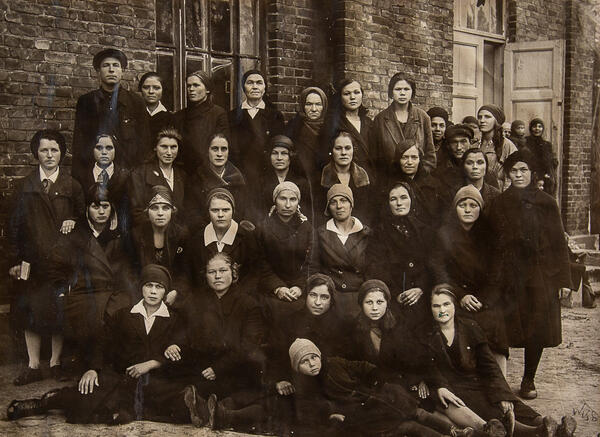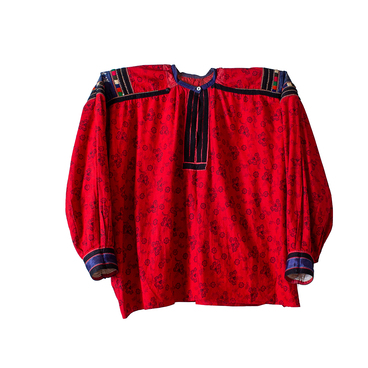The Stakhanovite movement originated in the Soviet Union in 1935. The movement took its name from a Soviet miner Alexey Stakhanov. He was a jackhammer operator in the Central Irmino mine in Donbas. During the night between August 30 and 31, 1935, Stakhanov and his team exceeded the target quota for their shift by 14.5 times. In just 5 hours and 45 minutes, they produced 102 tons of coal, instead of their quota of 7 tons. Later, on September 19 of the same year, the team set a new record by mining 227 tons of coal.
Stakhanov’s record marked the start of a new socialist competition at factories, plants, and production facilities all over the Soviet Union. Workers, collective farmers, and engineers who exceeded their production targets by many times were called Stakhanovites.
The 1932 photograph from the museum’s collection shows Stakhanovites of the Tambov Gunpowder Factory.
The Stakhanovite Movement was actively promoted by the All-Union Communist Party. Stakhanovites were respected members of society and received bonus payments.
To increase labor productivity, various production facilities implemented Stakhanovite practices: they made certain amendments to production processes, to make the work easier and more efficient. Measures to improve labor discipline were also introduced at all production facilities. The number of smoke breaks was decreased, and additional time was allocated for site preparation. Highly skilled workers were relieved of accessory works.
In the 1930s, a powerhouse for additional turbine generators, a new switchgear assembly, and a control panel were constructed at the combined heat and power plant of the Tambov Gunpowder Factory. Stakhanovite teams with many engineers and technical workers were set up for that critical mission. The factory introduced Stakhanovite shifts, days, and five-day periods — during these days, the production targets were higher. The best-performing employees were supported and rewarded. Courses under the guidance of Stakhanovites and socialist labor masters were organized at the factory, and a new education format was established to teach the required minimum of technical knowledge.
The national authorities and management of production facilities, including the Gunpowder Factory, rewarded high-performing workers. The Stakhanovites did not only receive bonus payments but were often provided with furnished apartments without a long wait. They were the first to receive scarce commodities, free trips to health resorts, and tickets to cultural events. Moreover, they were sometimes elected to positions of honor, sent to meetings with leaders of the All-Union Communist Party, awarded certificates and badges of honor.
Stakhanov’s record marked the start of a new socialist competition at factories, plants, and production facilities all over the Soviet Union. Workers, collective farmers, and engineers who exceeded their production targets by many times were called Stakhanovites.
The 1932 photograph from the museum’s collection shows Stakhanovites of the Tambov Gunpowder Factory.
The Stakhanovite Movement was actively promoted by the All-Union Communist Party. Stakhanovites were respected members of society and received bonus payments.
To increase labor productivity, various production facilities implemented Stakhanovite practices: they made certain amendments to production processes, to make the work easier and more efficient. Measures to improve labor discipline were also introduced at all production facilities. The number of smoke breaks was decreased, and additional time was allocated for site preparation. Highly skilled workers were relieved of accessory works.
In the 1930s, a powerhouse for additional turbine generators, a new switchgear assembly, and a control panel were constructed at the combined heat and power plant of the Tambov Gunpowder Factory. Stakhanovite teams with many engineers and technical workers were set up for that critical mission. The factory introduced Stakhanovite shifts, days, and five-day periods — during these days, the production targets were higher. The best-performing employees were supported and rewarded. Courses under the guidance of Stakhanovites and socialist labor masters were organized at the factory, and a new education format was established to teach the required minimum of technical knowledge.
The national authorities and management of production facilities, including the Gunpowder Factory, rewarded high-performing workers. The Stakhanovites did not only receive bonus payments but were often provided with furnished apartments without a long wait. They were the first to receive scarce commodities, free trips to health resorts, and tickets to cultural events. Moreover, they were sometimes elected to positions of honor, sent to meetings with leaders of the All-Union Communist Party, awarded certificates and badges of honor.



